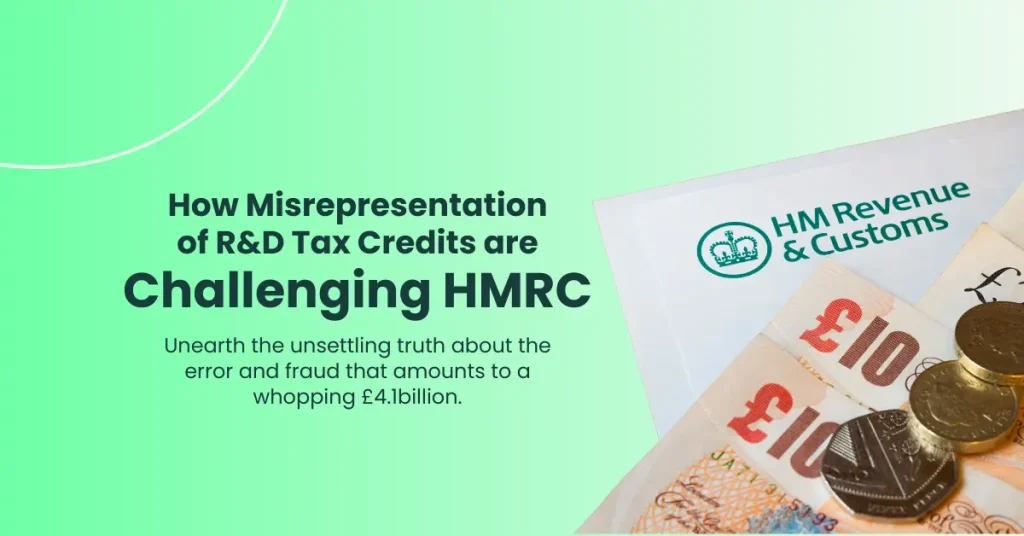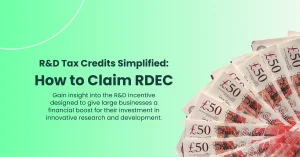How Misleading R&D Tax Credit Claims Challenge HMRC

Unearth the unsettling truth about the error and fraud that amounts to a whopping £4.1billion. Explore the steps that HMRC have taken to protect R&D tax credits, how to identify compliant consultants, and reveal how The Labour Party plans to further prevent fraud and errors throughout the future of the initiative.
Over the years, the R&D tax credits initiative has positioned itself as a necessary step in innovative advancement throughout the UK. With its generous delivery of financial benefits that continue to encourage businesses to invest in research and development, the initiative has often been highly celebrated.
But as with all great initiatives, there lies a dark side wherein a number of businesses formulate fraudulent claims in order to financially benefit from the generous scheme.
And so today, we’re going to explore what’s happening with R&D tax credits, how HMRC are working hard to safeguard the initiative, and how you can be certain your claim is authentic and compliant as per HMRC’s guidelines.
Latest Updates From HMRC
It’s been a rough couple of weeks for the newly appointed Labour government, after Chancellor of the Exchequer, Rachel Reeves, announced that over £20billion of public finances was missing. While the public demanded answers, the British government began to look into the whereabouts of the missing money.
While exploring the HMRC annual reports and accounts, it was later discovered that £4.1billion had been awarded to businesses later found to have submitted fraudulent or error filled claims. In fact, it’s estimated that over 1/6th of money spent on the R&D tax credit initiative was lost to fraud and error between the years of 2020 and 2022.
Given the extent of the misrepresentation in some R&D claims, critics have argued that the initiative is being abused by some businesses, but tax expert Colin Haley told a House of Lords committee in 2022 that there exists a “wild west” of tax accountants that pressure businesses to claim R&D relief.
Source: BBC News
In the light of these discoveries, it’s more important than ever to understand the following:
- The policies in place that aim to reduce fraud and error
- The documentation process to ensure your claim is error free
- How to identify genuine R&D tax credit consultants
Current Policies Aimed at Reducing Fraud and Error in R&D Tax Credit Claims
According to HMRC statistics, the fraud and error rate for R&D tax credits fell from 4.9% to approximately 3.6% due to the implementation of the following three measures.
- Digital submission mandates
- Additional information form requirements (AIF)
- Increased scrutiny and claim audits
While digital submission mandates and additional information requirements were implemented in order to aid in authenticating claims, HMRC has doubled the number of staff allocated to R&D tax credit claims in order to increase the amount of time dedicated to increasing scrutiny and claim audits.
HMRC Response to Fraud and Error
“With R&D claims, public money is at stake and taxpayers rightly expect us to scrutinise them, which is why we have increased compliance activity. We do that thoroughly and fairly, and the overwhelming majority of valid claims are paid on time.
Any customers who have a concern about an R&D claim they have made, or may have been made on their behalf, should email: rd.incentivesreliefs@hmrc.gov.uk They should title the email as ‘For the attention of the R&D Anti Abuse Unit’ “
Source: Tax Policy Associates
How to Identify Genuine R&D Tax Credit Consultants
Considering the fact that there is a wide range of accountants that pressure businesses to claim R&D tax credits even if they may not be technically eligible, it is important that you research consultants before proceeding to work with them.
Here are our four tips to identifying genuine R&D tax credit consultants:
- Check their qualifications and experience
- Verify their track record with HMRC
- Request references and case studies
- Review their approach to compliance
By gathering this information, you can verify the validity of a company when they claim to be a consultant that specialises in R&D tax credits.
Alexander Clifford’s Approach to Compliance
One of our greatest values is that we remain honest and transparent. In the interest of doing just that, we wanted to highlight the process that Alexander Clifford goes through in order to ensure that we only submit accurate, compliant R&D tax credit claims that align with HMRC guidelines.
With that in mind, the following steps highlight our approach to R&D tax credit compliance:
- Undergo a technical consult with a prospective client in order to identify the key aspects of the research and development project
- Use HMRC guidelines to decipher whether or not the project qualifies for the R&D tax credit incentive (those who don’t meet the requirements are informed and work with them ceases)
- Follow up in order to gather more information on the project’s activities and the R&D costs
- Request financial documentation to ensure that the R&D costs are accurate
- Request other necessary documentation to compile proof of your project and your claim
Following this, our specialist consultants will compile all of the necessary information as it pertains to HMRC’s guidelines, and submit the claim on the clients behalf. Not only does this process ensure that the claim is compliant, but it also simplifies R&D tax credit claims for our clients.
Book a quick call back
How Labour Plan to Reign in R&D Tax Credit Fraud and Errors
During the run up to the 2024 British election, The Labour Party mentioned in their manifesto that they are dedicated to implementing a Regulatory Innovation Office in order to combat fraud and error throughout the innovative R&D tax credit scheme.
While there has been no specific information from the government since they were voted into office last month, the manifesto that introduced the new office would:
“Prevent the need to reassess claims which could potentially jeopardise small businesses should they be ordered to pay back their tax credits”.
Source: Alexander Clifford: The Future of R&D Tax Credits
In conclusion, the spike in fraud and error is being actively challenged by HMRC who are dedicated to protecting the prowess of R&D tax credits. With a range of measures set out to strengthen the security of the incentive, and an increase in scrutiny, it’s clear that the HMRC are working hard to ensure that genuine innovative businesses are relieved of the financial burden often faced when participating in research and development.
So to ensure that your claim is fully compliant in regards to HMRC’s guidelines, and to get specialist advice from verified R&D tax credit consultants, enter your details in the contact form below.
Get a decision on your R&D eligibility from a qualified specialist in 15 minutes.







